MP33
| Location: Speed. | |
| Australian Soil Classification: Eutrophic, Subnatric, Red SODOSOL (medium sandy surface), overlying an older Red KUROSOL. | |
| General Landscape Description: Level area between north-south stranded beach ridges. | |
| Geology: Quaternary Woorinen Formation overlying Tertiary Parilla Sandstone. |
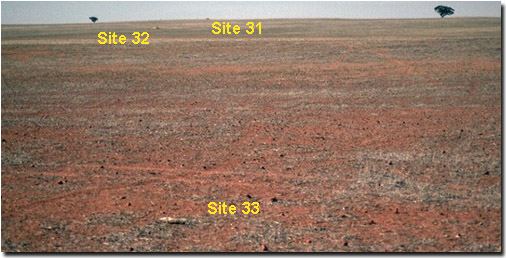 Site MP31, MP32 & MP33 Landscape |
Soil Profile Morphology:
Surface Soil
| A11 | 0-10 cm | Dark red (2.5YR4/8); sand; soft surface condition moist; structureless (single grain); very weak consistence moist; pH 7.4; abrupt and smooth change to: | 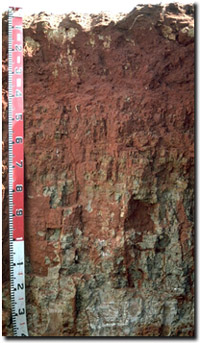 Site MP33 Profile |
| A12 | 10-30 cm | Dark red (10R4/8); clayey sand; massive; weak consistence dry; contains very many (>50%) sandstone gravel fragments (5 mm-15 cm in size); pH 7.6; abrupt and smooth change to: | |
| Subsoil | |||
| B21 | 30-40 cm | Dark red (2.5YR4/8); light medium clay; moderate coarse blocky structure (rough-faced peds); strong consistence dry; pH 8.0; abrupt and smooth change to: | |
| D1 | 40-60 cm | Dark red (2.5YR4/8); medium clay; strong coarse blocky, breaking down to strong medium blocky structure (smooth-faced peds); strong consistence dry; pH 5.6; gradual and smooth change to: | |
| D2 | 60-75 cm | Dark red (2.5YR4/8) with reddish yellow (7.5YR6/6) patches; light clay; strong coarse blocky, parting to strong fine blocky structure; strong consistence dry; pH 4.8; gradual and smooth change to: | |
| D3 | 75-120 cm | Light grey (5Y7/1) with brownish yellow (10YR6/8) mottles; heavy clay; strong very coarse prismatic, parting to strong coarse blocky structure; very strong consistence dry; contains few (2-5%) gypsum crystals in pockets; pH 4.8; clear change to: | |
| D4 | 120+ cm | Light grey (2.5Y7/2); sandy clay; very strong consistence dry; pH 4.8. | |
Key Profile Features:
- Strong texture contrast between surface (A) horizons and the sodic subsoil (B21) horizon ie. Sodosol
- Overlies Tertiary land surface developed on Parilla Sandstone.
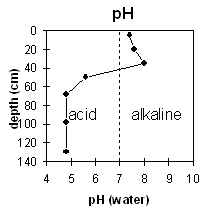 | 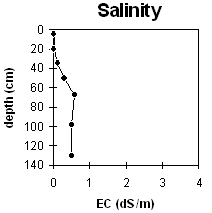 |
The surface soil is slightly alkaline. Upper subsoil is moderately alkaline. The deeper subsoil becomes very strongly acid with depth. | The salinity rating is very low for the upper profile becoming moderate at about 70 cm. |
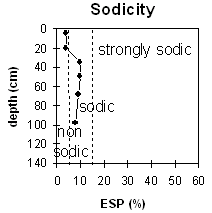 | |
The surface soil is non-sodic. The subsoil is sodic throughout. |
Management Considerations:
Whole Profile
- In general, management strategies for all soils should aim to: increase organic matter levels in the surface soil, minimise the degradation of soil aggregates and porosity, promote the development of stable biopores, break up any hardpans, and improve the calcium status of the ion exchange complex. Particularly when sodium plays a significant part i.e. the soil is sodic. Less frequent tillage, using less aggressive implements, and working the soil at optimum moisture conditions can all assist in maintaining soil aggregation and porosity, as well as reducing the breakdown of organic matter. Farming practices on cropping soils such as residue retention, minimum tillage and pasture rotations could be utilised to build up organic matter, reduce erosion risk and increase the soils inherent fertility.
Surface (A) Horizons
- The sandy surface has a very low water holding capacity and inherent lack of fertility. Increasing the low organic matter levels of the surface horizon will help to improve these characteristics as well as assisting in erosion risk and soil aggregation.
- These sandy surface soils show a degree of water repellence that may restrict water infiltration at the surface.
- The low wilting point value (i.e. 3 %) of the surface horizons indicates that plants will be able to utilise light rains when the soil is dry. However, due to the low water storage capacity, plants will soon suffer moisture stress unless further rainfall occurs.
Subsoil (B) Horizons
- The salinity rating becomes moderate at about 70 cm. These levels of soluble salts are likely to restrict the growth of salt sensitive plant species (e.g. faba beans, linseed, chickpeas and lupins).
- The subsoil becomes very strongly acid at 70 cm. Exchangeable aluminium levels can be high in strongly acid soils.
- The coarsely structured subsoil is sodic and strong dispersion occurs as a result, restricting root and water movement into the subsoil.
Comments: At the time of sampling the site was under pasture for sheep.
Profile Described By: Mark Imhof, Paul Rampant and Sonia Thompson (18/4/95).


